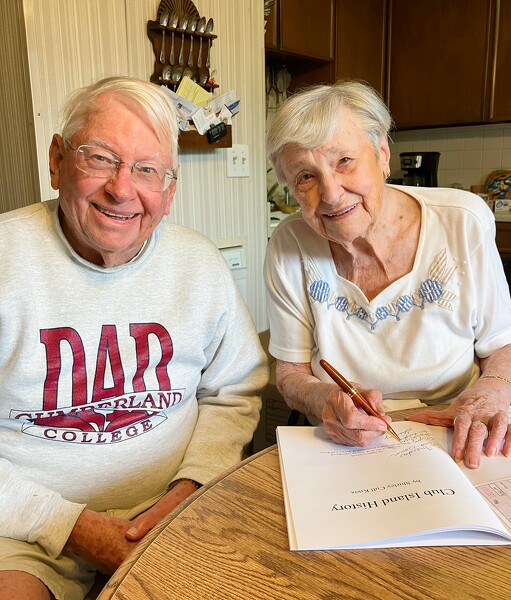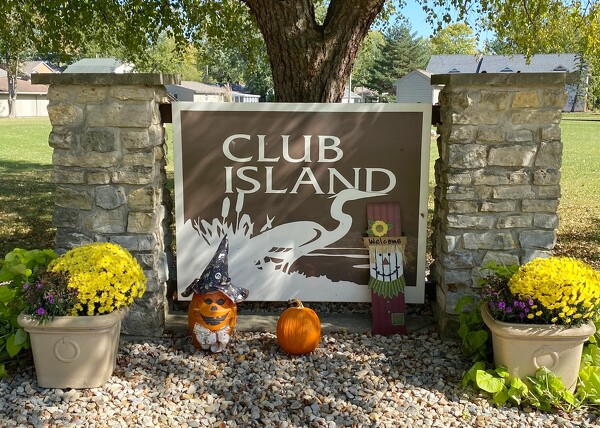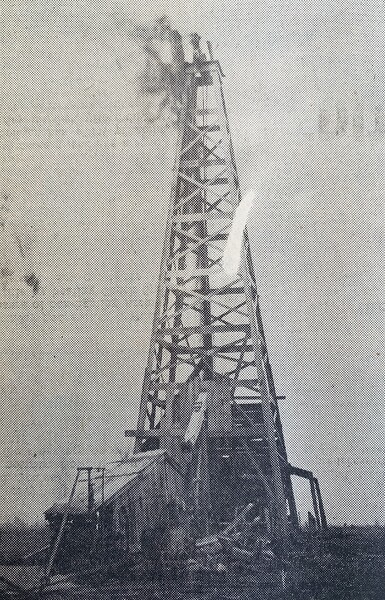
Shirley Knox signs a copy of "Club Island History" for neighbor Donn Roberts.
FRANKLIN TOWNSHIP - Club Island resident Shirley Knox marked two accomplishments in August: She published her first book and celebrated her 97th birthday.
Knox began drafting "Club Island History" in the 1970s but had to set it aside for decades. But finishing the book would fulfill a request made years ago by longtime Mercer County historian Joyce Alig.
"In 2022 I restarted the project," she said.
The book takes the reader through both the development of the land and the founding of a community.
Club Island is located in Franklin Township on the southern shore of Grand Lake. It was one of the last communities around the lake to be developed.

A parade of homes face Grand Lake on the western side of Club Island.
Before its residential development, the land of Club Island had a long history of both recreational and public use, going back to when Gov. Charles Foster signed a deed transferring 45 acres from the State of Ohio to the Mercer County Shooting and Fishing Club of Cincinnati in May 1880.
Early maps show the area to be a true island. Later maps show more of a peninsula, with a road connecting Club Island to the mainland. The name presumably came from the Shooting and Fishing Club that made its hideaway there for decades.
In 1909, the club sold the acreage, and over the following decades it saw use as a getaway for the business and social leaders of New Bremen, a state-owned public "resort" and boating facility known as "Lakeside Park," and several private tracts that had been sold off.
All that changed in 1950 when Beatrice Hecht Kessler sold a large amount of property on the peninsula to Ellsworth Dorsten. In the fall of 1951, Dorsten filed the plat of Dorsten Club Island Addition with the Mercer County Recorder, and the Club Island subdivision was born. A second addition was platted in 1954.
Knox said Club Island was the hardest area around the lake to develop because the terrain was so swampy. "To the east and south of Club Island is a lot of swamp land," Knox writes. Although deep and narrow, lakefront lots sold quickly.
Hugh and Shirley Knox were living in Dayton when they began looking for a weekend place at Grand Lake St. Marys. They were impressed with the area. In 1954 the Knoxes became the owners of a weekend cottage on the lake.
The developers built a gravel road onto the island that included a small causeway, the only way onto the island except by boat. A well was dug to supply all lots with water, and each homeowner was required to pay for hookup to the well and for a septic tank.
Knox recalls there were many houses on the lakefront but not on the back of Club Island, which was swampland. The island was still primitive and mosquitoes and dusty roads were a problem. "Only a few people lived here full-time," she said.
Most island property owners, including the Knoxes, were weekenders and hosted many visitors. Children, grandchildren, cousins and friends all wanted to come to the lake, Knox notes in the book.
In 1956 the Club Island Association was formed, and the development became the privately owned, privately governed community it remains today. All landowners were required to join the association.
One of the first projects of the association was to pave the roads. Residents paid dues for road upkeep and other services. Non-members sometimes used the boat ramps and roads, creating the need for additional upkeep, so members voted to place signs advising of the private community at the entrance.

First developed in the early 1950s, Club Island is privately owned and privately governed.
"Club Island History" covers many key steps in the development of the island, from solving water system problems to managing seawalls to the "building ban" of 1975-1985 to the installation of a sewer system in the late 1980s.
Residents also drained and excavated a small pond on the south end of the peninsula to make a much larger pond that became a center of community life.
"As the water drained from the pond, project participants used their hands to scoop up fish and other wildlife and put them into large garbage cans to be emptied into the lake," Knox writes. "Club Island resident Jim Tesno was about ten years old at this time, and he remembers watching all this activity."
The new pond was a "wonderful" success, Knox said. It was clean enough for swimming, better for fishing, and allowed boats from the lake to pass under a bridge into the pond, where a boat dock was built. Knox also remembers ice skating and bonfires on the frozen pond during winters.
Knox recounts many community events and activities that were held over the years. A hot air balloon ascension gave a homeowner the chance to win a ride in one of the balloons. Knox's brother belonged to an antique car club, and members from the group came to Club Island to put on a car show. A homeowner from Dayton was an expert with fireworks, so for many years there were special displays in the commons area for residents.
John and Wanda Gilliland also deserve credit for development of the island, the book notes. They donated farmland north of Club Island for wildlife use. The Gilliland Sanctuary and Gilliland Nature Preserve continue to benefit many species today, including the nature-loving humans from Club Island and throughout the Grand Lake region.
For entertainment and community cohesion residents formed a Bunco game club about 10 years ago. They meet for lunch once a month and enjoy the afternoon playing the dice game.
Today, there are about 50 residences in the development. Knox said Club Island is a close-knit community, the kind of neighborhood where people check on each other.
"It's nice when people check on each other," she said.

The cover of "Club Island History" by Shirley Knox.
Knox began writing as a catharsis after she lost a leg to cancer in 1964. She later volunteered with the Mercer County Historical Society, where she talked to director Joyce Alig, who soon encouraged her to write a history of Club Island.
"Club Island History" is a self-published book printed by Messenger Press in Carthagena. A limited-edition printing is already sold out, but Knox has established a waiting list for a possible second printing. Those interested in being added to the waiting list can contact Bev Badgett at 937-418-9363.
Knox acknowledges several people who helped her with the process. Jim Tesno contributed with historical information he had collected over the years. Donn and Freida Roberts encouraged her to keep going with the writing. Barbara Moore did the editing and helped put the whole project together.
"Above all, Club Island is a great place to live because residents have made it that way. Their hard work and neighborly spirit have created a community I am proud to call home,"Knox writes. "I wish to preserve Club Island history for future generations."



